
GSHP System: The Top Mechanical Choice for Facilities in Gunnison County, Colorado
By Terry Proffer, CGD, Geothermal Manager, Major Geothermal
The city of Gunnison and Gunnison County in Colorado is known for its summer and winter recreational activities, sightseeing, western history, and the ski resort town of Crested Butte. Gunnison is the location of Western Colorado University, a public university currently enrolling about 3,000 students. The local economy also includes farming and ranching. With an elevation range of 7,700 feet to mountains approaching 14,000 feet above sea level, the area is also known for its cool summers and cold winters. Due to its cold climate, ground source heat pump (GSHP) systems are particularly attractive for their lower operating costs.
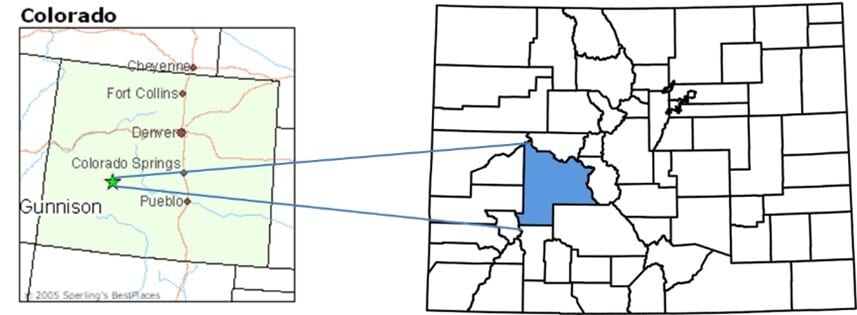
Climate
- The city of Gunnison’s historic climate data1 describes a chilly environment:
- 35°F average annual temperature, including summer highs.
- 10,019 heating degree days, base 65°F
- 0 cooling degree days, base 70°F - hot days and extended cooling duration loads are limited!
- Lowest recorded winter temperature, -47°F below zero
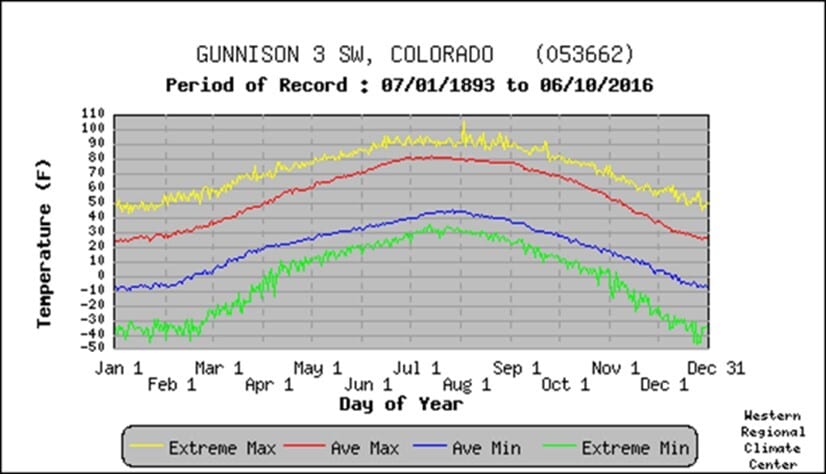
Residential Installation Example
Believed to be the first GSHP installation in the Gunnison Basin, the Cox residence just east of the city of Gunnison was completed in 1997, with a 3,500 ft² floorplan and heated by a radiant floor (no cooling). The GSHP system consists of a nominal 6.0-ton water-to-water unit tied to a closed loop trenched 4-Pipe field of four 300’ long x 8’ deep trenches x 2’ wide using ¾” DR11 circuit pipe. To maximize thermal momentum, the buffer tank is a 120-gallon unit, and the radiant floor was designed to not require more than 100°F supply water temperature to maintain zone setpoints. There is no backup boiler or other heating system. The heat pump was sub metered to break out actual power consumption and operating cost.
During the first year of operation (1997-1998) the homeowner reported a total power consumption for the GSHP system of 3,251 kwh. The power rate at the time was $0.0699/kWh, equating to a total first year heating cost of $227.24, or about $0.065 per ft² per year2. The original system is still operating; due to its sealed closed loop ground heat exchanger, the installation requires very little maintenance.
Other Area GSHP Installations
The exact number of GSHP installations in Gunnison County is unknown, but several residential installations are accounted for between Gunnison and Crested Butte, and various rural areas throughout the county. Western Colorado University recently completed a new facility that utilizes a closed loop GSHP system, the Paul M. Rady School of Computer Science & Engineering, which includes the Mechanical Engineering department.
Reasons for Pursuing GSHP Installations for Gunnison County Facilities
Mr. John Cattles, Assistant County Manager of Operations & Sustainability, has been involved with evaluating the various county facilities for several years, including operating cost and maintenance. He noted that over the years the most expensive costs were related to the mechanical systems, both in terms of operating and maintenance. Mr. Cattles began investigating alternate mechanical systems, including GSHP technology.
He also noted other considerations: “Gunnison County is concerned with environmental impacts and mitigating our greenhouse gas emissions. We want to lead by example in electrification of our buildings. We try to do things ourselves before we consider regulations or code changes. We are remote and are interested in the resilience of distributed HP systems.”
As a county executive, John also hears from employees about comfort and mechanical reliability, as these are priority subjects where winter conditions can be extreme. John notes that since their first GSHP installation “Comfort and control is improved compared to other systems”.
John states that “GSHP technology has been a game changing strategy to reduce energy use and GHG emissions. We have found that GSHP installations result in much greater savings than previous efficiency efforts, and GSHP technology aligns well with our on-site PV for additional benefits”.
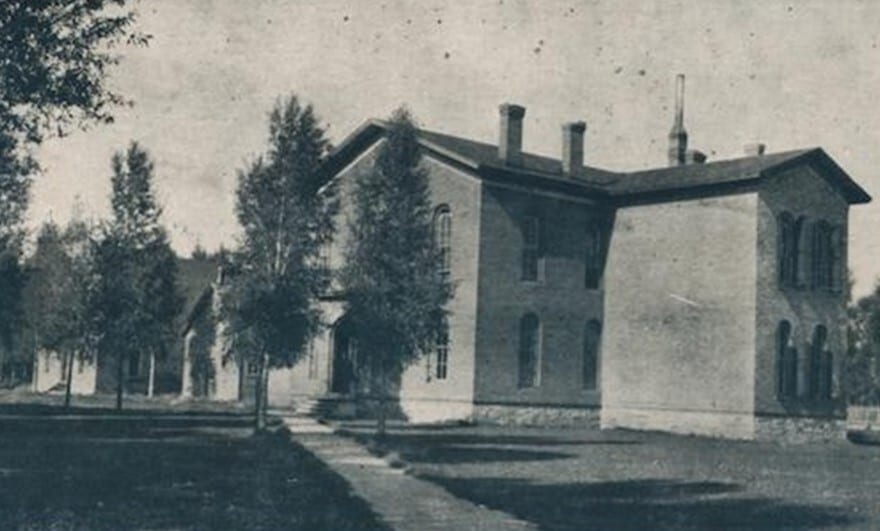
Original Gunnison County courthouse, circa 1880s.
Gunnison County Courthouse
The first GSHP system for the county was installed in the county courthouse. In 2014-2015 the facility underwent a remodel involving a new construction update of the facility, while retaining some of the historic architecture of the original 1881 construction.
The combined new construction and retrofit of the building has 46,000 ft² of conditioned space. The peak cooling load is 624 kBtuh and peak heating load is 492 kBtuh; the peak cooling load is higher due to internal gains despite the cold climate. The facility has 64 packaged water-to-air GSHP units with a nominal capacity of 90 tons. The closed loop ground heat exchanger (GHX) consists of 40 bores of 315’ depth using 1.25” DR11 u-bend circuits. The original design called for 400’ depth bores but was scaled back due to difficult drilling conditions found during the thermal conductivity test.
A predesign of the field was done to make certain the field layout was compatible with existing and planned infrastructure, and to select the test bore location that could be integrated into the final field design regardless of final number of bores, hindering configuration, spacing, and other variables.
As this was the first GSHP system for a county facility, a backup boiler was installed to temper the ground loop water should it drop below the operating temperature of the heat pumps. The only time the boiler is operated is to exercise it.
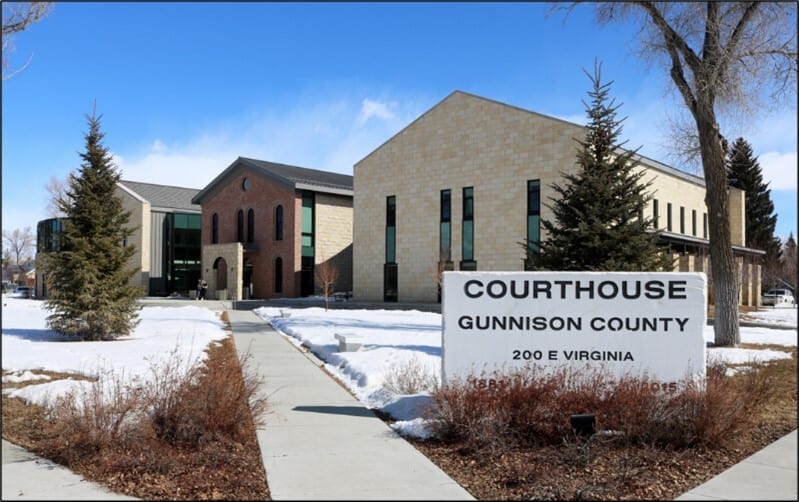
Completed courthouse.
From John Cattles:
- Since 2015 when the facility became operational, utility costs have been reduced from $1.76 to $0.52 per ft² per year.
- With the later addition of a 100kW photovoltaic solar array in 2020, providing up to 50% annual power demand, operating cost has been further reduced to $0.38 per ft² per year.
- Heat pumps were originally programmed to all come online at once from evening setback, but later staggered to reduce peak power demand (lessons learned)
- Comfort is exceptional.
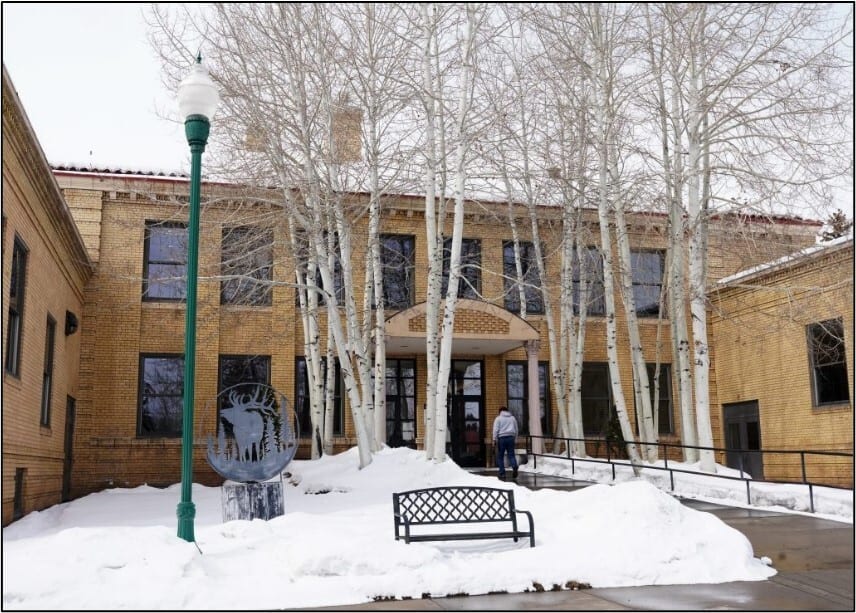
The 26,200 ft² Blackstock Building (photo from Southwest Energy Efficiency Project web site)
Blackstock Building
The Blackstock Building has served as a local government administration and community space since its construction in 1926. The building was originally heated using steam from a coal fired boiler. The last renovation to the building was in 1999 when the county upgraded to boilers and chillers, but gradually those systems experienced multiple failures.
When the building was retrofitted to a GSHP mechanical system, completed in 2021, the facility remained open. During the mechanical transition time, the facility was at times being conditioned by both the new GSHP and the existing mechanical systems.
The GSHP system consists of the following:
- 30 bores x 340’
- 20 nominal tons of water-water heat pumps
- 72 tons of packaged water-air heat pumps
From John Cattles:
- The older central boiler/chiller system was prone to failure and could take down the entire building.
- The former 4-Pipe system driven by boiler/chiller plant was uncomfortable and controls were problematic.
- Since retrofitting to distributed heat pumps, reliability is high and has added resilience to the facility.
- Utility costs have been reduced from $1.11 to $0.58 per ft² per year.
- Maintenance is lower with the GSHP system and controls are simplified.
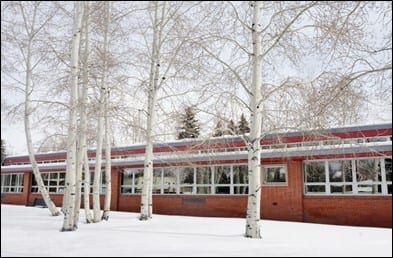
The 11,600 ft² Health & Human Services building (photo from Southwest Energy Efficiency Project web site)
Health & Human Services Building
Gunnison’s Health and Human Services building, built in 1952, houses the County’s Human Services, Public Health, and Child Welfare departments. As the building aged, the original heating and cooling system struggled to maintain comfortable temperatures for the staff. The facility was retrofitted in 2017 with a GSHP mechanical system. In 2020 a 25kW solar array was added.
The GSHP system uses a closed loop ground heat exchanger of 18 boreholes of 350’ depth, with a total of 28 nominal tons of heat pump capacity between eight water-air packaged heat pumps.
Since the building is a retrofit, and detailed operating costs have been recorded, the before and after energy use reduction is impressive as described in this graph3:
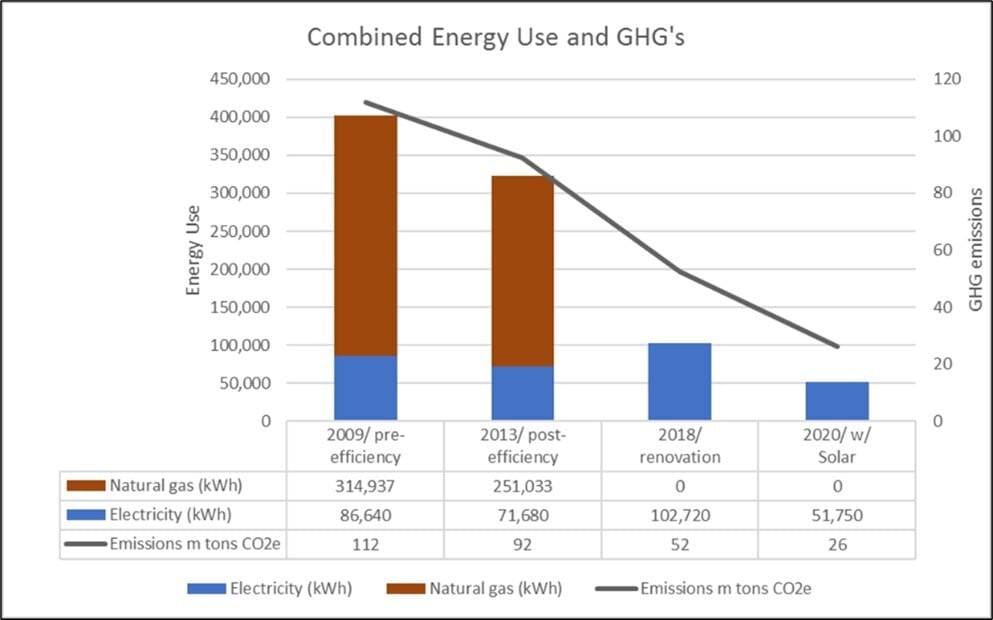
Gunnison County Library
The new 15,000 ft² Gunnison County Library was completed in 2022. Conditioning is by a GSHP system and electrical power is supplemented with a 25kW solar array. The calculated building loads are 192 kBtuh cooling and 288 kBtuh heating.
The GSHP system is composed of a closed loop GHX of 18 bores x 400’ depth using 1.25” DR11 u-bends, servicing 12 water-air packaged heat pumps totaling 36 nominal tons of capacity. There is no backup heat of any kind.
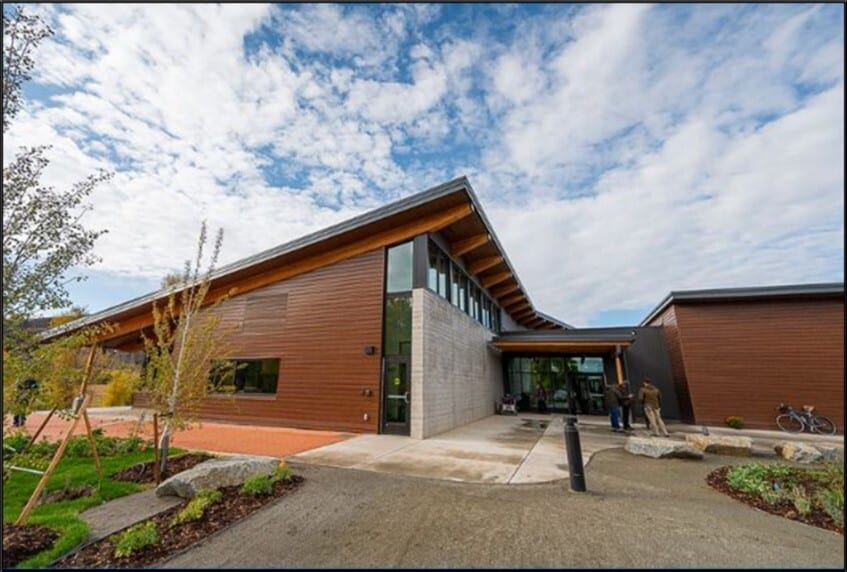
Mechanical room, Gunnison Library.
From Mr. Drew Lockhart, Executive Director, Gunnison County Libraries: “The December 2022 and January 2023 electric bills were $62 and $72 dollars. This is amazing considering that all the heat for the 15,000 square foot library shows up in the electric bill. The library increased its square footage by 10,000 (from the original facility) and reduced its average energy costs by $350 per month. The library has been at 70 degrees all winter, it’s very comfortable with an even heat.”
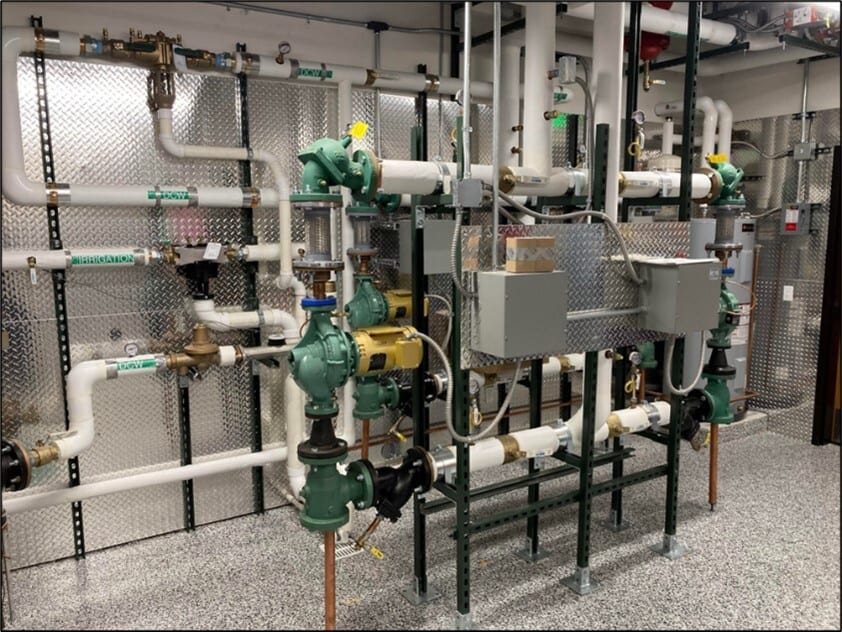
Mechanical Room, Gunnison Library
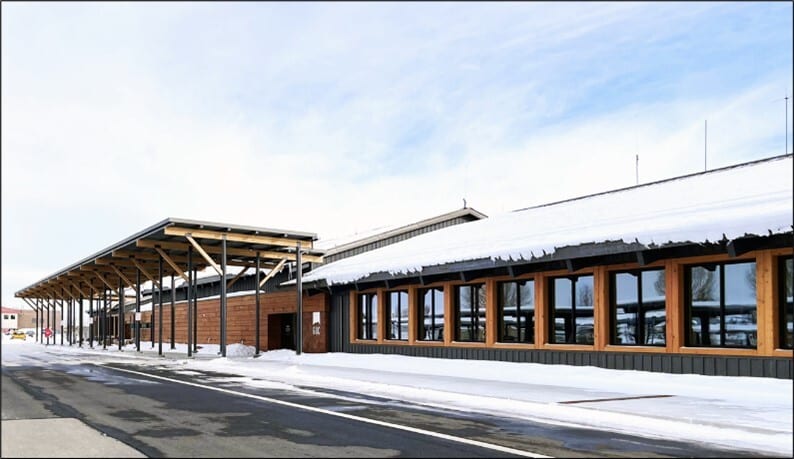
Rendering courtesy Gensler Architects.
Gunnison-Crested Butte Regional Airport, Main Terminal Renovation
The 42,000 ft² main terminal at Gunnison-Crested Butte Regional Airport (GCBRA) was originally built in 1983 and retrofitted with a GSHP system in 2021.
The hourly load analysis determined a peak cooling load of 576 kBtuh and a peak heating load of 192 kBtuh. While the peak cooling load is higher than that of the heating peak, the total annual loads are heating dominant; the high peak cooling loads are of short duration due to those times of high occupancy related to airline arrivals and departures.
The heat pumps are tied to a closed loop GHX consisting of thirty-two 400’ bores using 1.25” DR11 u-bends. There are two large water-water heat pumps and 36 water-air packaged units totaling 165 nominal tons of heat pump capacity.
Based upon the most recent utility invoicing, the total electric cost is coming in at about $0.84 per ft² per year4.

Interior photo of terminal (from https://gunnisoncrestedbutte.com)
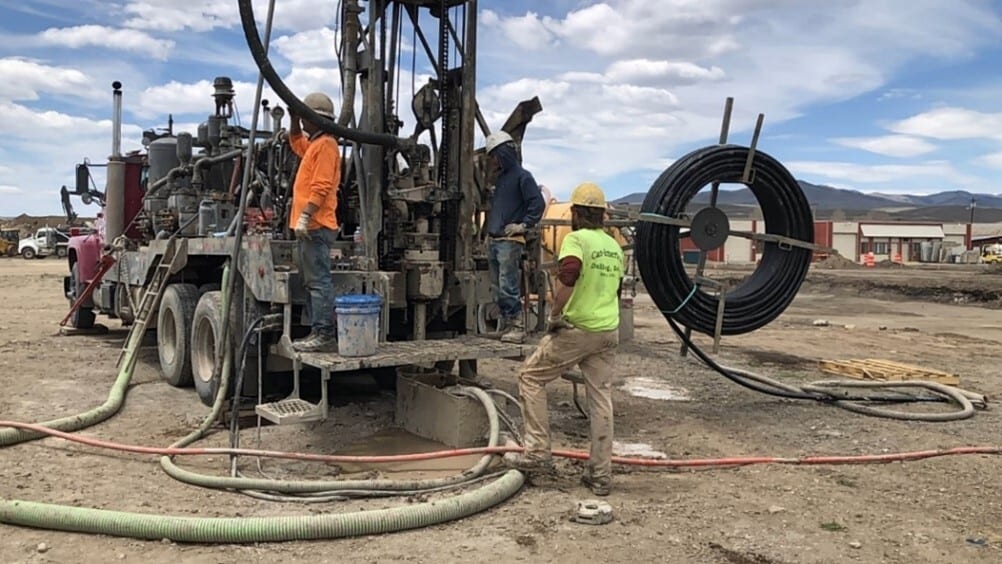
Installing one of the ground loops for the GCBRA Terminal project.
Gunnison Valley Emergency Medical Services
Currently under construction, the GVEMS facility is slated to be operational later in 2024. This 17,500 ft² facility has a peak cooling load of 134 kBtuh and a peak heating load of 144 kBtuh, as determined from the hourly load analysis.
The offices and administration areas will be conditioned by packaged water-air heat pumps and the apparatus bays by radiant floor heat driven by water-water heat pumps. The GHX is a closed loop vertical system composed of twelve bores of 440’ depth with 1.25” DR11 u-bends.
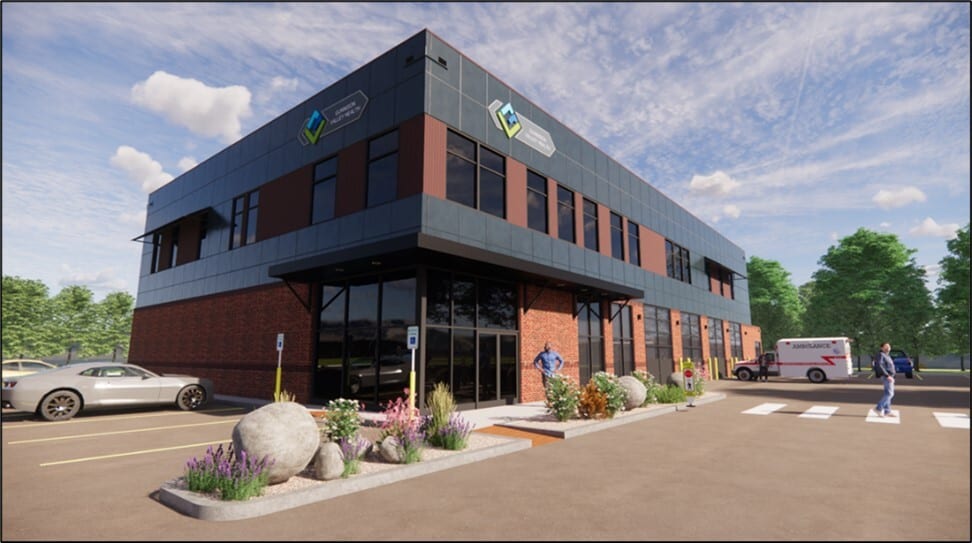
Architect’s conceptual image, courtesy Falk Architects.
Other Projects
There are two housing developments currently in design, the Sawtooth affordable housing apartments, and the Whetstone workforce project. The Sawtooth facility will be a three-story complex and is located adjacent to the Gunnison-Crested Butte Regional Airport. The Whetstone project will be comprised of several apartment and condominium complexes, located between the cities of Gunnison and Crested Butte. Both projects will use GSHP mechanical systems as influenced by Gunnison County.

Takeaways
By tracking utility and maintenance costs of various buildings, Gunnison County has determined that GSHP mechanical systems are advantageous for lowest operating and maintenance costs. Accordingly, GSHP systems are the first choice, when possible, for any new construction or retrofit county facilities.
Gunnison County management not only tracks mechanical costs, but they have also undertaken to understand the design process for any mechanical system option and are an active participant with the mechanical design team when a GSHP system is planned for any county buildings. Their objectives are for the least complex, easiest to maintain, and most efficient system for meeting their sustainable objectives and still provide a comfortable working environment in their facilities. They also realize that if designed and executed correctly, backup heating measures are unnecessary, which aids in their net zero objectives.
Footnotes:
1 From Desert Research Institute, https://wrcc.dri.edu/Climsum.html
2 Personal communication with owner
3 Courtesy of John Cattles
4 Personal communications with John Cattles
Terry Proffer, CGD, Geothermal Manager, Major Geothermal

IMAGE CREDIT: Getty Images / Boogich / iStock / Getty Images Plus

